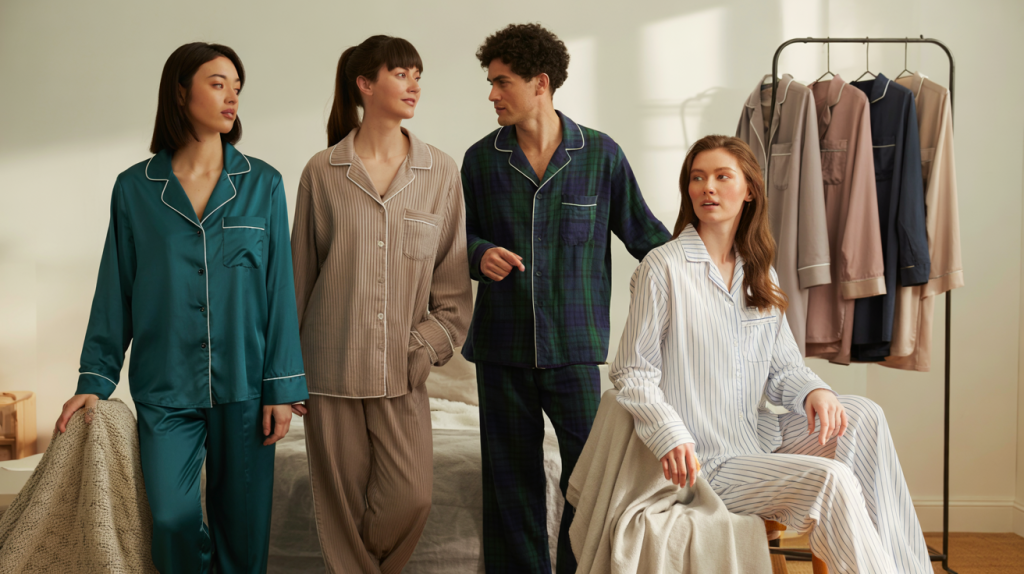The right pajamas change the whole night. Softer fabric, smarter cuts, fewer wake-ups. That is why the best pajama brands stand out: thoughtful materials, clean seams, durable dyes, and a fit that moves with the body instead of fighting it.
Readers ask for a shortcut. Here it is. From heritage specialists like Hanro, founded in 1884 in Switzerland, to fresh disruptors like Lunya, launched in 2014, and SKIMS, introduced in 2019 and valued at 4 billion dollars in July 2023 according to the Wall Street Journal, these labels earn their spot by fabric science, consistent sizing, and real-world comfort.
Best pajama brands: comfort, quality, sustainability
Shopping pajamas can feel noisy. Different blends, buzzy claims, seasonal prints. The main idea is simpler: buy sleepwear that breathes, stretches without sagging, and survives the wash. Below, trusted names for various styles and budgets.
One brand rarely does everything. Some excel at featherlight modal, others at brushed flannel or technical knits. A quick tour helps avoid the usual missteps like buying thick flannel for a warm apartment or slippery satin that traps heat.
These picks rely on clear brand histories and product families. Hanro dates to 1884 and still centers on premium cottons and mercerized finishes. Uniqlo partnered with Toray Industries to launch HEATTECH in 2003, a benchmark for thermoregulating basics. Sleepy Jones arrived in 2013 with tailored pajama sets that read more art studio than sofa.
• Bullet list of the best pajama brands by need
- Lunya – Launched in 2014 by Ashley Merrill, known for washable silk that drapes beautifully and holds up in real life.
- Eberjey – Since 1996, buttery modal sets with relaxed collars and piping that never feel stuffy.
- Hanro – Established 1884 in Switzerland, impeccable cottons and long-wearing knits for minimalist sleepers.
- SKIMS – Debuted 2019, soft rib sets and stretch fits. Reported 4 billion dollar valuation in 2023 signals demand for everyday comfort.
- Uniqlo – HEATTECH from 2003 helps in cooler rooms, while AIRism keeps summer nights dry.
- Marks et Spencer – Founded in 1884, reliable flannels and jersey sets across inclusive sizing.
- L.L.Bean – Since 1912, brushed flannel pajamas with sturdy seams for decades-long winters.
- Brooklinen – Started 2014, jersey and cotton poplin sets that match its bedding quality.
- Parachute – Founded 2014, breathable linen and cloud-soft Turkish cotton for airy sleepers.
- Soma – Launched 2004 under Chico’s FAS, smoothing knits and cooling lines designed for comfort first.
- Muji – Since 1980, pared-back cotton and gauze sets with simple, calm silhouettes.
- Sleepy Jones – Born 2013, crisp cotton poplins and prints that look grown-up, not cutesy.
How to choose pajama fabrics, fits and certifications
What trips people up most is fabric. Cotton poplin feels cool but has less give. Modal and Tencel lyocell feel silky, drape well and breathe. Linen rules for hot sleepers. Flannel shines below 15°C rooms and cabins. Choose the weave for your room temp, not the weather outside.
Next, fit. A classic notched-collar set looks sharp but can pull at the shoulders if the rise and sleeve ease are tight. Raglan or drop-shoulder tops help broader frames. If you toss and turn, ribbed or jersey knits avoid that twisty, sheet-tugging feel.
Care labels matter. Washable silk from Lunya reduces dry-cleaning. HEATTECH or AIRism from Uniqlo signals purpose-built yarns. Certifications like GOTS for organic cotton or OEKO-TEX Standard 100 indicate fabrics tested for harmful substances. That is peace of mind for sensitive skin.
Common mistakes people make – and easy fixes
Buying the thickest set for warmth is a classic mistake. Breathability keeps you comfortable through sleep cycles. Midweight knits often beat heavy flannel in apartments with central heating.
Another miss: ignoring waistband construction. Wide, soft elastics or drawstrings that anchor well will stop the midnight shimmy. Brands like Eberjey and SKIMS design waistbands to stretch without digging.
Allergic to scratchy tags? Hanro and Parachute often use printed or soft labels. Small detail, big upgrade. And yes, color counts. Dark dyes can transfer when new – wash once cold before a first wear.
Price, longevity and where the value actually sits
Upfront price can feel steep, but cost per wear tells a clearer story. A 100 dollar set worn 100 nights in a year runs 1 dollar per night. Cheaper sets that pill or shrink cut comfort fast.
Brand age can signal consistency, not just nostalgia. Hanro’s 1884 origin reflects knitting expertise passed down. L.L.Bean’s 1912 roots show in its flannel weight and seam strength. At the same time, younger labels often push fabric tech. Uniqlo’s 2003 HEATTECH launch showed how yarn engineering can change winter basics.
Where to start if decisivness is tough. Hot sleeper in a small bedroom – pick linen from Parachute or lightweight modal from Eberjey. Cold sleeper or drafty home – Uniqlo HEATTECH pajamas or L.L.Bean flannel. Want a gift that lands – washable silk from Lunya, or a crisp poplin set from Sleepy Jones. That last choice tends to photograph beautifully, which, let’s be honest, also matters.
